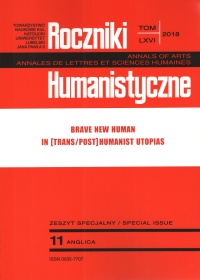“Let the race die out”: A Strange Case of Trans/ Post-humans in Mary Bradley Lane’s Feminist Utopia Mizora: A Prophecy
Abstract
The prevailing criticism of Mary Bradley Lane’s Mizora: A Prophecy, a 19th-century utopia that entered the feminist literary canon after it was reissued by Greg Press in 1975, relatively unanimously assumes that the asexual subterranean race of the Mizorans represents homo sapiens. Perceived by the narrator—a visitor from Tsarist Russia and a friend to Polish insurrectionists—as women representing an advanced civilization, and only sporadically as fairies, the race of “blonde beauties” is believed to be typical of feminist utopias. Undermining genderification present in the narratorial as well as critical discourse, the article will claim that the status of Mizorans, the race spawned by scientists thousands of years ago, wavers between transhuman and posthuman.
References
Bartowski, Frances. Feminist Utopias. Lincoln: University of Nebraska Press, 1989. Print.
Bostrom, Nick. “A History of Transhumanist Thought.” Journal of Evolution and Technology 14.1 (2005): 1—25. Print.
Bostrom, Nick. “Why I Want to Be a Posthuman When I Grow Up.” The Transhumanist Reader. Ed. Max More and Natasha Vita-More. 28–53. Print.
Bradley, Mary E. Lane, Mizora: A Prophecy [1889]. Lincoln: University of Nebraska Press, 1999.
Broad, Katherine. “Race, Reproduction, and the Failures of Feminism in Mary Bradley Lane’s Mizora.” Tulsa Studies in Women’s Literature, 2.28 (2009), U.S. WOMEN WRITING RACE. 247–266. Print.
Bruce, Karen A. “Aryans in Utopia: Mary Bradley Lane’s Mizora as an Example of the Contemporaneity of the Utopian Form.” Topic 56 (2010): 23–32. Print.
Claeys, Gregory. Dystopia: A Natural History. Oxford: Oxford University Press, 2016. Print.
Johns, Alessa. “Feminism and Utopianism.” The Cambridge Companion to Utopian Literature. Ed. Gregory Claeys. Cambridge: Cambridge University Press, 2010. 174–199. Print.
Johns, Alessa. Women’s Utopias of the Eighteen Century. Champaign: University of Illinois Press, 2003. Print.
Kessler, Carol Farley (ed.). Daring To Dream: Utopian Fiction by United States Women Before 1950. Second edition. Syracuse: Syracuse University Press, 1995. Print.
Kleinberg, S. J. Women in the United States 1830–1945. Houndmills: Macmillan, 1999. Print.
Mahady, Christine. “No World of Difference: Examining the Significance of Women’s Relationships to Nature in Mary Bradley Lane’s Mizora. Utopian Studies 15.2 (2004): 93–115. Print.
More, Max and Natasha Vita-More, eds. The Transhumanist Reader: Classical and Contemporary Essays on the Science, Technology, and Philosophy of the Human Future. First Edition. Malden: Wiley-Blackwell, 2013. Print.
Nayar, Pramod K. Posthumanism. Cambridge: Polity Press, 2014. Print.
Pfaelzer, Jean. “Introduction.” Mizora: A Prophecy by Mary E. Bradley Lane. Syracuse: Syracuse University Press, 2000. Print.
Pfaelzer, Jean. “A State of One’s Own: Feminism as Ideology in American Utopias 1880–1915.” Extrapolation 24.4 (1983): 311–328. Print.
Pfaelzer, Jean. The Utopian Novel in America 1886–1896: The Politics of Form. Pittsburgh: Univeristy of Pittsburgh Press, 1984. Print.
Roden, David. Posthuman Life Philosophy at the Edge of the Human. London: Routledge, 2015. Print.
Sandberg, Anders. “Morphological Freedom—Why We Not Just Want It, but Need It.” The Transhumanist Reader. Ed. Max More and Natasha Vita-More. 56–64. Print.
Sargent, Lyman Tower. “Themes in Utopian Fiction in English before H.G. Wells.” (1976). Web.
“Transhumanist Declaration (2012).” The Transhumanist Reader. Ed. Max More and Natasha Vita-More, 2013. 54–55. Print.
Copyright (c) 2018 Roczniki Humanistyczne

This work is licensed under a Creative Commons Attribution-NonCommercial-NoDerivatives 4.0 International License.





